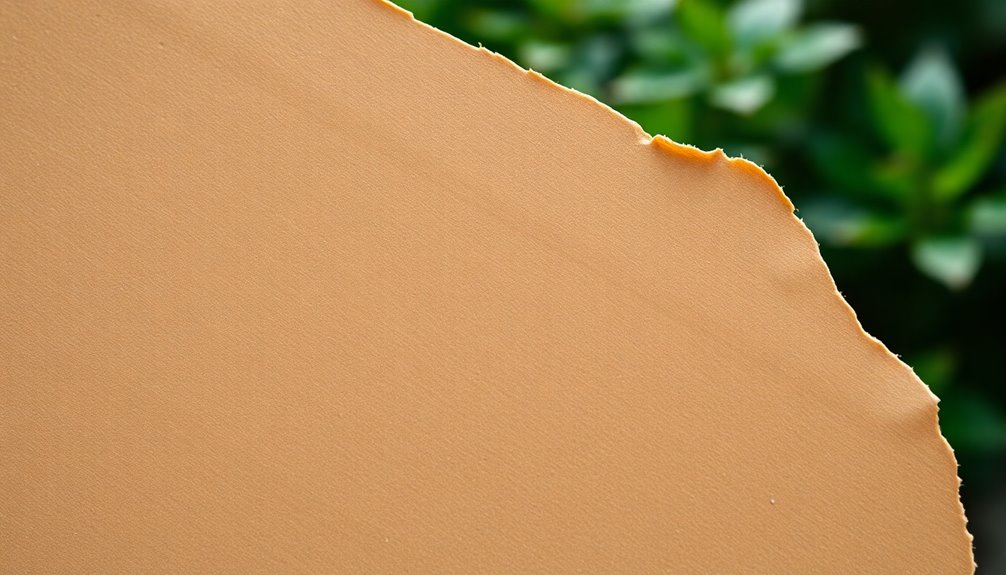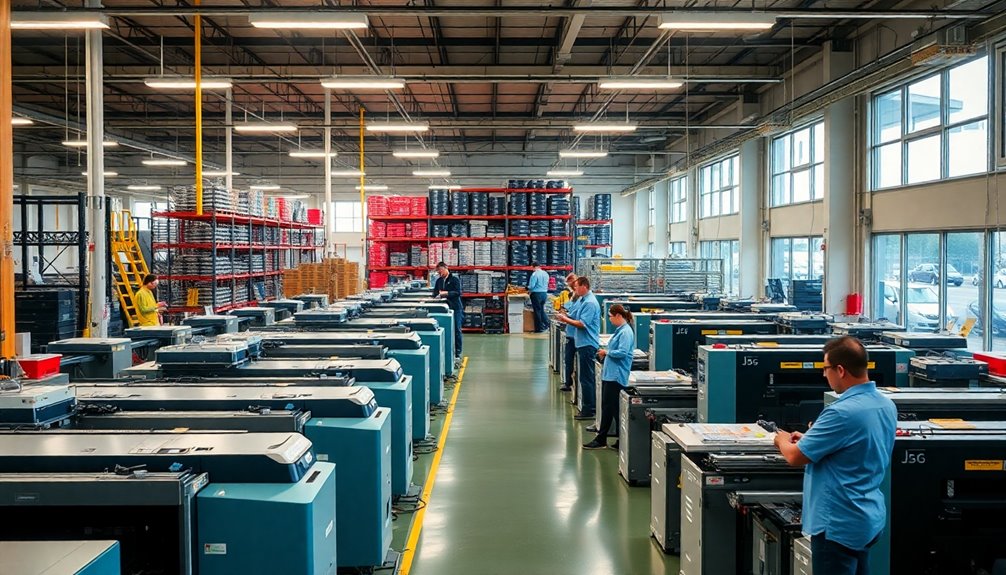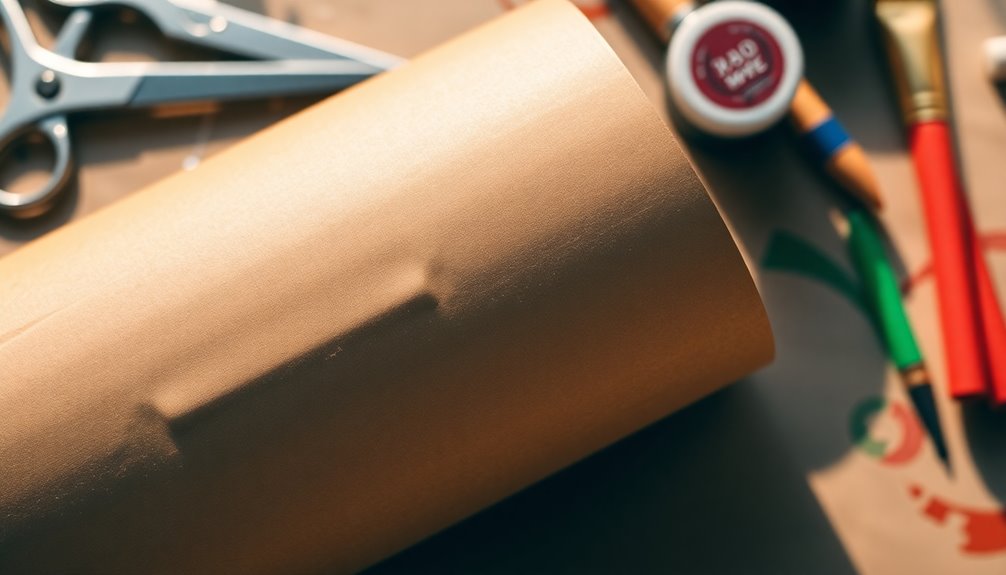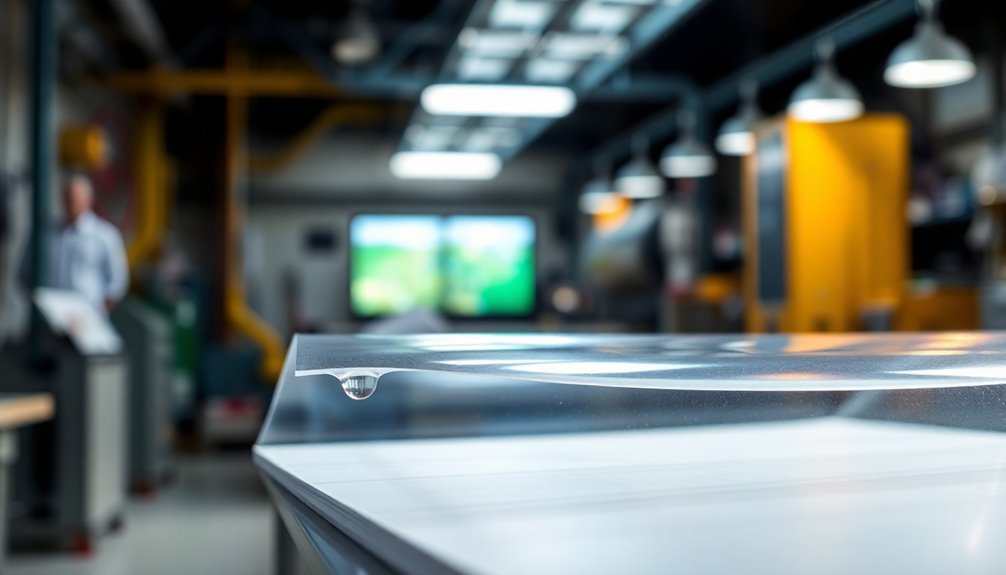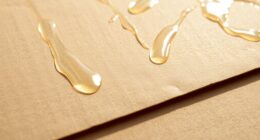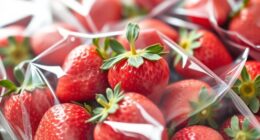Kraft cardboard is often made from both virgin and recycled paper. When it includes recycled paper, it's typically collected, sorted, and cleaned before being pulped with virgin fibers for added strength. While recycled kraft cardboard is a more eco-friendly option, it has a shorter fiber length, which can lower its tear strength. If you're looking for sustainable solutions, you'll find that kraft cardboard is fully recyclable and biodegradable. This makes it great for those who care about the environment. Keep exploring to discover more about how kraft cardboard meets both durability and sustainability needs.
Key Takeaways
- Kraft cardboard can be made from virgin paper, recycled paper, or a mix of both, depending on the desired strength and sustainability.
- Recycled kraft cardboard contains shorter fibers, which may result in less tear strength compared to virgin kraft cardboard.
- Recycled kraft cardboard requires a heavier grammage (10-15% more) to achieve similar strength to virgin kraft cardboard.
- Both virgin and recycled kraft cardboard are 100% recyclable and biodegradable, supporting sustainable practices.
- Kraft cardboard production uses less energy and water, especially when incorporating recycled materials, minimizing environmental impact.
Understanding Kraft Cardboard
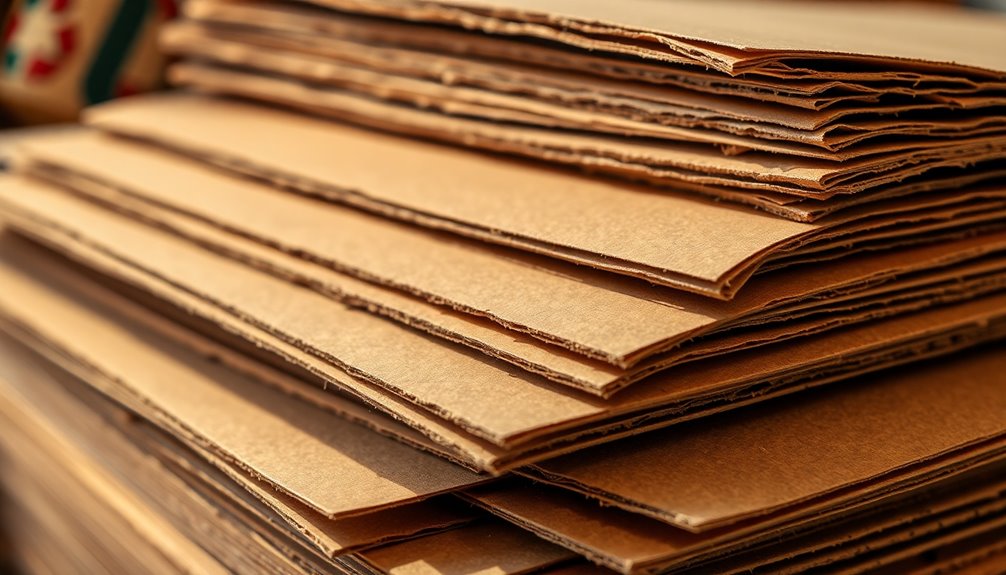
Kraft cardboard, made from either virgin or recycled kraft paper, offers a unique blend of strength and sustainability. When you choose kraft cardboard for your packaging solutions, you're opting for a material that's both eco-friendly and highly functional.
The production process involves the chemical treatment of wood pulp, which gives it superior tear strength and durability. While virgin kraft cardboard boasts long cellulose fibers that enhance its performance, you can still find reliable options in recycled paper, especially for less demanding applications.
Recycled kraft cardboard may not match the tear strength of its virgin counterpart due to shorter fibers from multiple recycling stages. However, it remains a viable choice for sustainable packaging, often requiring heavier grammage for similar strength.
As consumers increasingly seek eco-friendly products, the market for kraft cardboard continues to grow, with projections estimating its market value will reach $22.38 billion by 2028. By selecting kraft cardboard, you contribute to reducing reliance on petroleum-based materials while supporting a circular economy that emphasizes recycling and sustainability.
Composition of Kraft Cardboard
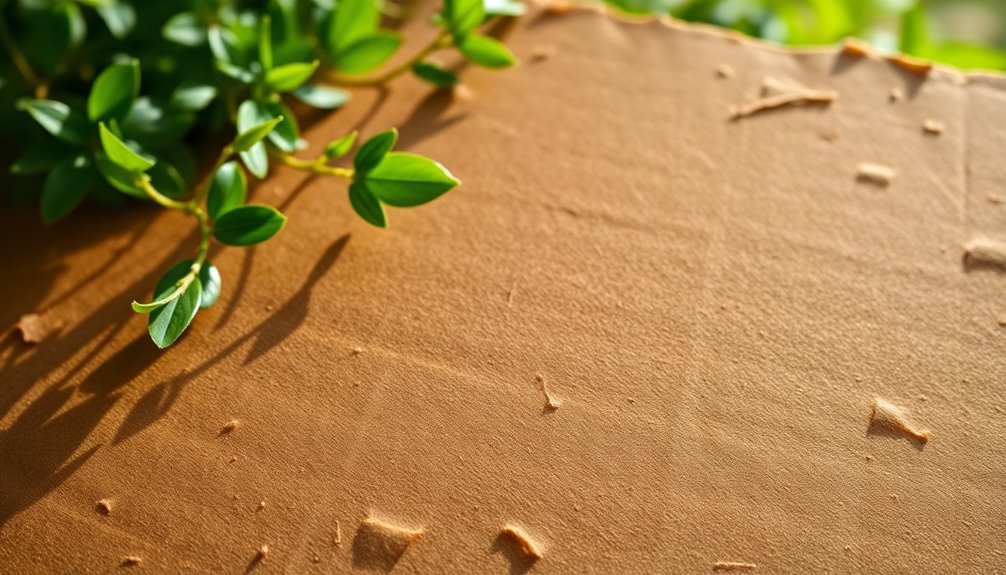
The composition of kraft cardboard plays a crucial role in its performance and sustainability. Primarily made from virgin pulp derived from wood fibers, kraft cardboard offers high strength and durability, especially for heavy-duty applications. Long fibers enhance its tear and tensile strength, making it ideal for packaging products that endure rough handling.
However, there are variations that incorporate recycled paper, resulting in mixed kraft cardboard, an eco-friendly option. Here's a quick comparison to help you understand the differences:
| Type | Composition |
|---|---|
| Virgin Kraft Cardboard | Made from virgin pulp |
| Recycled Kraft Cardboard | Made from post-consumer paper waste |
| Strength | High strength |
| Grammage | 10-15% heavier for recycled types |
Recycled kraft cardboard, while less sturdy than its virgin counterpart, is useful for non-heavy-duty applications. It's important to note that to match the strength of virgin kraft, recycled versions often require a heavier grammage. By choosing kraft cardboard, you're opting for a material that balances performance with sustainability, especially when considering recycled options.
The Role of Recycled Paper

Recycled paper plays an essential role in producing kraft cardboard, offering an eco-friendly alternative that meets modern sustainability demands. By incorporating recycled paper into the manufacturing process, you help reduce the reliance on virgin fibres, which greatly lowers the environmental impact associated with tree harvesting.
This shift toward sustainable materials not only supports the planet but also aligns with consumer preferences for greener products.
Kraft cardboard can be made entirely from recycled materials or blended with virgin fibres for enhanced strength and durability. It's crucial to highlight that recycled paper fibers can be reused 6-7 times before they become too short for further production, impacting the overall quality.
To achieve comparable performance characteristics, kraft cardboard made from recycled paper often requires a grammage that's 10-15% heavier than that made from virgin Kraft. This additional weight guarantees that the final product maintains its strength and durability, making recycled kraft cardboard increasingly favored in various packaging applications.
Environmental Benefits of Kraft
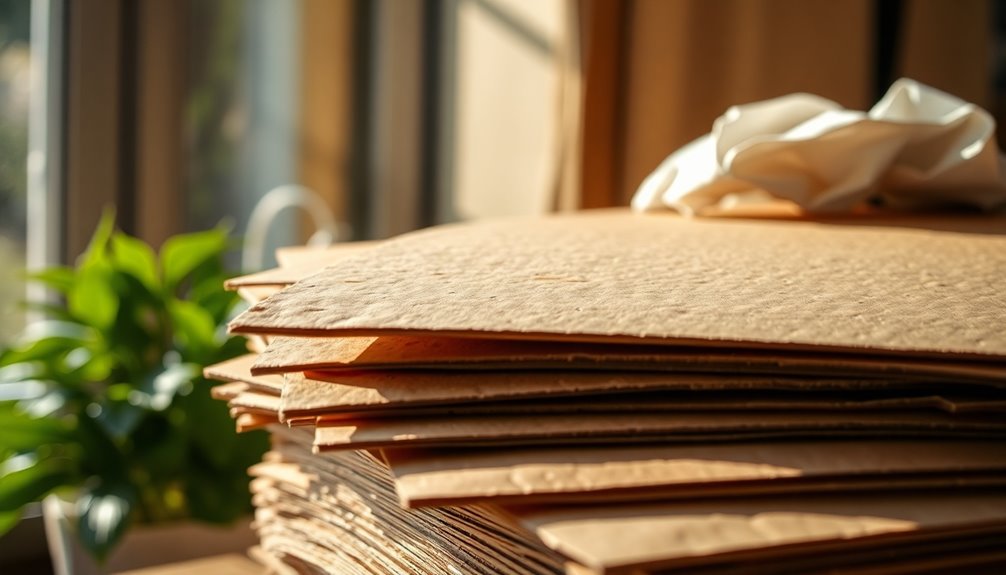
Choosing kraft cardboard, especially when it's made from recycled materials, brings considerable environmental benefits. By opting for kraft cardboard, you're supporting a more sustainable packaging option that helps reduce the demand for new raw materials. This choice promotes eco-friendly practices that contribute to a healthier planet.
Kraft cardboard made from recycled paper requires less energy and water during production compared to using virgin materials. This makes it a more environmentally friendly option that can considerably lower carbon emissions associated with manufacturing.
Additionally, kraft cardboard is 100% recyclable and biodegradable, which helps minimize landfill waste and lessen your overall environmental impact.
Incorporating recycled content in kraft cardboard supports a circular economy by reusing materials instead of relying on tree cutting and resource depletion. This not only conserves natural resources but also encourages responsible consumption.
Kraft vs. Recycled Cardboard
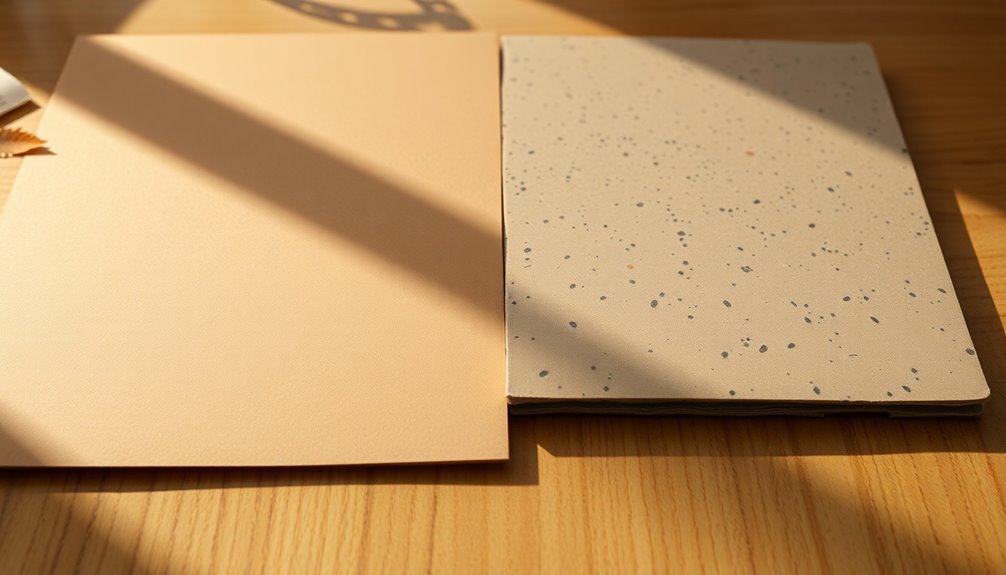
When comparing Kraft and recycled cardboard, you'll notice significant differences in material composition and performance.
Kraft cardboard, made from virgin wood pulp, offers superior strength and moisture resistance, making it ideal for heavy-duty applications.
In contrast, recycled cardboard relies on used paper, which can compromise its durability and effectiveness in demanding conditions.
Material Composition Differences
Kraft cardboard and recycled cardboard differ considerably in their material composition, which affects their strength and durability. Kraft cardboard is primarily made from virgin wood pulp, providing it superior strength characteristics. In contrast, recycled cardboard is composed of post-consumer recycled paper, leading to shorter fibers and reduced strength. The kraft process used in producing Kraft cardboard enhances its durability, while the multiple recycling stages for recycled cardboard can degrade fiber quality over time.
Here's a comparison of their material composition:
| Feature | Kraft Cardboard | Recycled Cardboard |
|---|---|---|
| Material Source | Virgin wood pulp | Post-consumer recycled paper |
| Strength Characteristics | High tear and tensile strength | Weaker due to shorter fibers |
| Moisture Resistance | Higher moisture resistance | Lower moisture resistance |
| Production Process | Kraft process | Multiple recycling stages |
| Sustainability | Less sustainable | More sustainable |
Due to its robust moisture resistance, Kraft cardboard is often preferred for heavy-duty applications. While the market shifts towards sustainability, recycled cardboard requires heavier grammage to match Kraft's performance.
Performance Characteristics Comparison
While both Kraft and recycled cardboard serve important roles in packaging, their performance characteristics differ markedly due to their material origins and structural properties.
Kraft cardboard, made from virgin fibers, boasts high tensile strength and tear resistance, making it ideal for heavy-duty applications and rough handling. In contrast, recycled cardboard consists of shorter fibers from used paper, which limits its strength and durability, especially after multiple recycling processes.
To match the performance of Kraft cardboard, recycled cardboard often requires a grammage that's 10-15% heavier, compensating for its weaker fiber structure. This added weight can impact overall efficiency and cost-effectiveness.
Additionally, Kraft cardboard excels in moisture resistance, making it the better option for humid or cold storage environments where packaging integrity is essential.
While Kraft cardboard shines with superior stacking strength and load-bearing capacity, recycled cardboard performs better in dry conditions.
Understanding these distinct performance characteristics can help you choose the right material for your specific packaging needs, ensuring ideal protection and efficiency for your products.
Manufacturing Process Explained
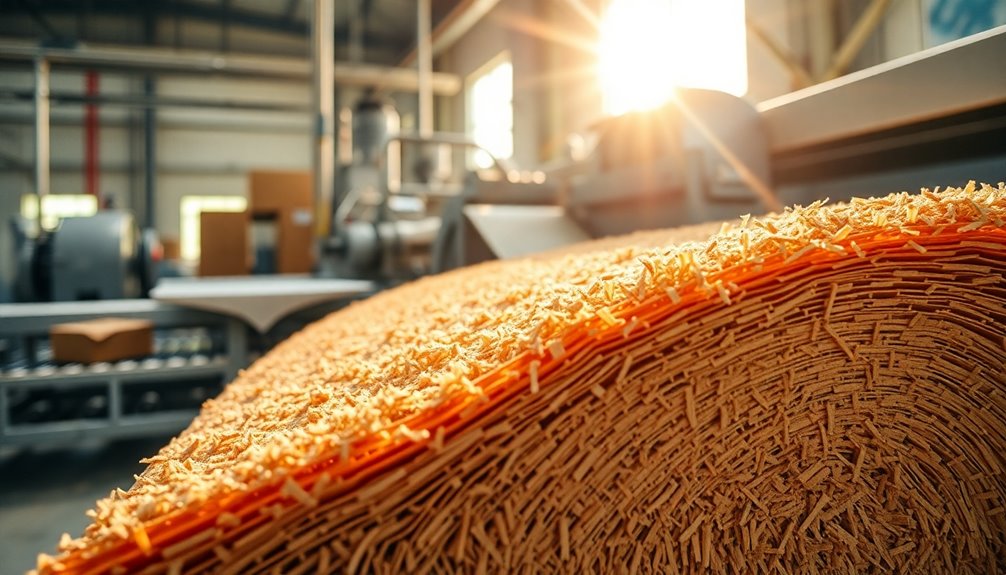
How does the manufacturing process of kraft cardboard incorporate recycled paper? It all starts with collecting used paper fibers, which are then sorted and cleaned to remove any contaminants.
Once the recycled paper is ready, it's pulped, breaking down the fibers into a slurry. This pulp forms the backbone of your kraft cardboard.
Next, if additional strength is needed, manufacturers mix in virgin fibers with the pulp. This combination helps create a robust product suitable for various uses.
The slurry is then formed into sheets through a process involving drainage and pressing, which shapes the mixture into a flat, sturdy form.
After they've been formed, these sheets are dried and rolled, preparing them for cutting and converting into the final kraft cardboard products, like boxes and packaging materials.
Applications of Kraft Cardboard
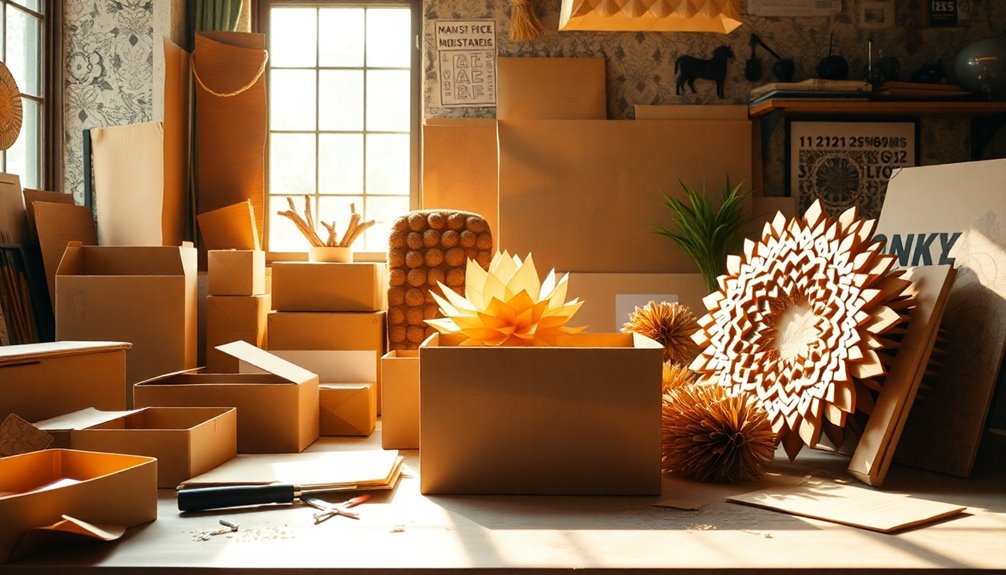
Kraft cardboard's strength makes it an excellent choice for heavy-duty shipping solutions, ensuring your products arrive safely.
Plus, its eco-friendly nature appeals to those looking for sustainable packaging options.
Whether you're packing up a shipment or wrapping a gift, kraft cardboard delivers both durability and environmental benefits.
Heavy-Duty Shipping Solutions
When it comes to heavy-duty shipping solutions, Kraft cardboard stands out for its impressive strength and versatility. This material, often composed of virgin fibers or a mix with recycled paper, provides higher tear and tensile strength, making it ideal for shipping heavy items. Its durability guarantees that products remain safe during transit, even in demanding industrial sectors.
Kraft cardboard's moisture resistance is another significant advantage, especially when shipping perishables like fresh fruits, vegetables, and meat products. Plus, it's commonly used for packaging dangerous goods, guaranteeing compliance with safety standards.
As eco-conscious businesses increasingly seek sustainable packaging solutions, Kraft cardboard's recyclability enhances its appeal. Here's a quick overview of its benefits in heavy-duty shipping:
| Feature | Benefit |
|---|---|
| Strength | High tear and tensile strength |
| Moisture Resistance | Protects perishables |
| Safety Compliance | Suitable for dangerous goods |
| Durability | Ideal for heavy items |
| Sustainability | Recyclable and eco-friendly |
Eco-Friendly Packaging Options
In today's market, businesses are increasingly recognizing the importance of eco-friendly packaging options that don't compromise on quality. By choosing Kraft cardboard, especially the recycled variety, you align your brand with sustainability efforts while appealing to environmentally conscious consumers.
Recycled Kraft cardboard offers several advantages:
- Biodegradable: It breaks down naturally, reducing landfill waste.
- Durable: Its strength makes it perfect for heavy-duty applications.
- Moisture Resistant: This property protects products during transit.
- Versatile: It's suitable for various packaging needs, from e-commerce shipments to food containers.
Utilizing recycled Kraft cardboard not only supports sustainability but also enhances your brand's image.
With 74% of consumers willing to pay more for eco-friendly packaging, your choice impacts purchasing decisions. By opting for this biodegradable material, you contribute to a lower environmental impact while maintaining the quality and protection your products deserve.
Strength and Durability Features
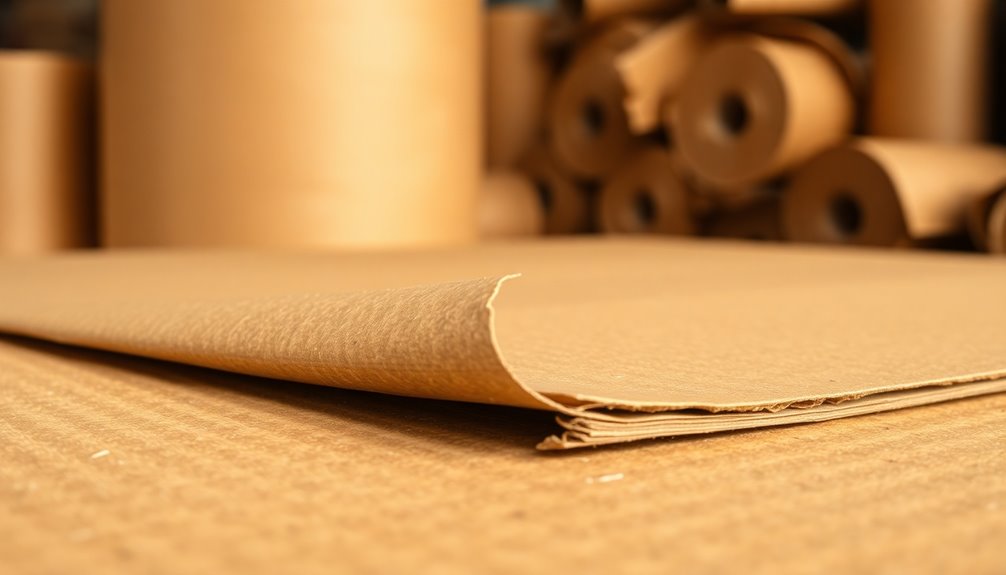
Made from either virgin pulp or a blend of virgin and recycled fibers, kraft cardboard boasts impressive strength and durability features that cater to various applications. Its long fiber composition gives it high tear and tensile strength, making it ideal for heavy-duty uses.
While recycled kraft paper offers some durability, it generally requires a heavier grammage—about 10-15% more—to match the performance of virgin kraft cardboard.
In industries like food packaging and dangerous goods shipping, the strength of kraft cardboard is crucial. High moisture resistance and structural integrity are critical to guaranteeing products remain safe during transport and storage.
Kraft cardboard also exhibits excellent stacking strength in dry conditions, allowing it to support heavy loads without compromising performance.
Moreover, its superior folding resistance and toughness make kraft cardboard a reliable choice for logistics. This guarantees that your products reach their destination safely while minimizing damage risks.
Whether you're using recycled kraft paper or opting for virgin pulp, understanding these strength and durability features is essential for making the right choice for your packaging needs.
Market Trends in Kraft Products

You might notice a significant shift in consumer demand for kraft products, driven by the growing preference for eco-friendly packaging.
As more people prioritize sustainability, brands are adapting their strategies to meet these expectations.
This trend not only reflects a change in purchasing behavior but also highlights the increasing importance of recyclable materials in today's market.
Consumer Demand Growth
Growing consumer demand for sustainable packaging solutions is reshaping the kraft paper market. You might be surprised to learn that around 74% of consumers are willing to pay more for products packaged in eco-friendly materials. This shift in consumer preference is driving a considerable increase in the demand for kraft paper packaging.
Key factors fueling this growth include:
- Rising awareness of plastic waste and pollution
- The versatility and strength of kraft paper for various applications
- The increasing popularity of recycled kraft paper
- The surge in online shopping requiring sustainable packaging alternatives
As global solid waste production reaches alarming levels, with 275 million metric tons of that being plastic, the urgency for eco-friendly packaging solutions is more pronounced than ever.
Kraft paper's durability makes it an ideal choice for e-commerce shipping, food packaging, and even arts and crafts. As the market for kraft paper boxes is projected to reach $22.38 billion by 2028, your preference for sustainable options can considerably contribute to reducing plastic waste and promoting the use of recycled kraft paper in everyday products.
Eco-Friendly Packaging Shift
The kraft paper market is undergoing a significant transformation as more consumers and businesses embrace eco-friendly packaging solutions. With projections showing the market could reach $22.38 billion by 2028, a growing interest in sustainable solutions is evident.
You'll find that 74% of consumers are now willing to pay a premium for products using eco-friendly packaging, reflecting a major shift in consumer preferences.
E-commerce's rise has spurred increased usage of kraft paper products, as companies look for biodegradable alternatives to combat plastic pollution. North America, with its strong food industry and established recycling practices, is expected to dominate this market, further highlighting the trend toward environmentally responsible packaging.
As awareness of plastic pollution grows, businesses are turning to kraft products to enhance their eco-conscious image. By choosing kraft paper made from recycled paper, you're not only supporting sustainability but also responding to a market that prioritizes green initiatives.
This shift signifies a broader movement toward minimizing environmental impact, ensuring that packaging aligns with your values and those of like-minded consumers.
Sustainable Packaging Practices
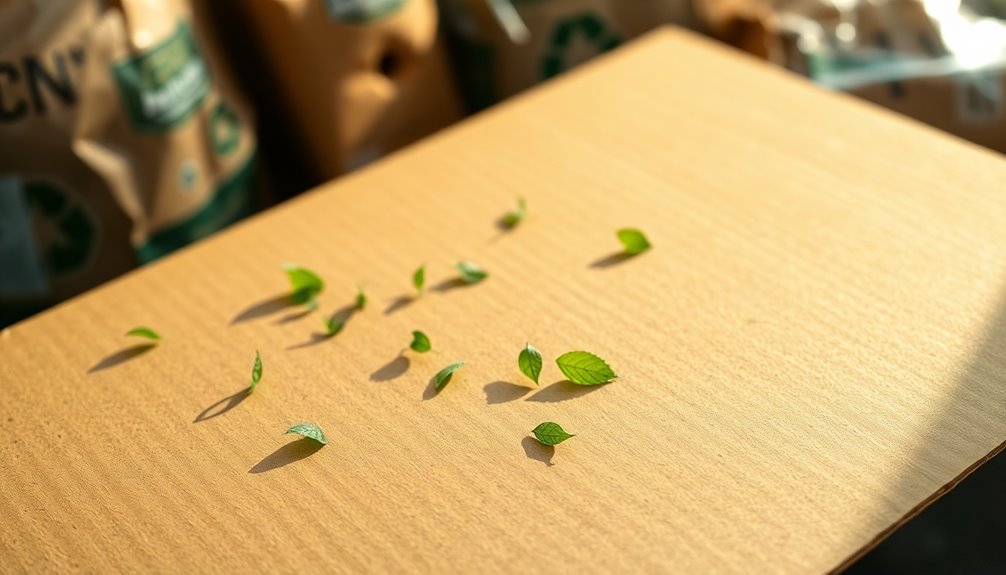
Sustainable packaging practices are increasingly essential in today's eco-conscious market, where consumers are actively seeking out environmentally friendly options. Kraft cardboard plays a pivotal role in this shift, as it can be produced using either recycled paper or virgin pulp. By focusing on recycled materials, you help reduce the need for virgin fiber, which minimizes tree cutting and promotes a circular economy.
Here are some key benefits of using kraft cardboard in sustainable packaging:
- Recyclable and biodegradable: Kraft cardboard breaks down naturally, making it a sustainable choice.
- Reduced reliance on virgin pulp: Utilizing recycled paper helps decrease the environmental impact of packaging production.
- Stronger market demand: Consumers are increasingly willing to pay more for eco-friendly packaging solutions, ensuring long-term viability.
- Supports waste reduction: Incorporating recycled materials promotes the use of waste products, aligning with eco-conscious values.
As the demand for sustainable packaging grows, opting for kraft cardboard not only fulfills consumer preferences but also supports a greener planet. Additionally, the use of solar technology in manufacturing processes can further enhance sustainability by reducing overall carbon emissions.
Frequently Asked Questions
Is Kraft Paper a Recycled Paper?
Kraft paper can be made from recycled sources, but it isn't exclusively recycled paper.
You'll find that it can also come from virgin pulp, which gives it superior strength and durability.
If you're considering kraft paper for your projects, remember that recycled versions may have shorter fibers and can vary in quality.
Does Cardboard Count as Paper Recycling?
Yes, cardboard definitely counts as paper recycling.
When you recycle cardboard, you're helping conserve resources and reduce waste. The process involves breaking down the cardboard into fibers, which can then be reused to create new paper products.
Since cardboard can be recycled multiple times, you're playing a part in a more sustainable cycle.
Is Kraft Paper the Same as Cardboard?
Kraft paper isn't the same as cardboard, even though they're both used in packaging.
Kraft paper is made from wood pulp and known for its strength, while cardboard consists of multiple layers and often includes recycled materials.
You'll find kraft paper in rolls, but cardboard usually comes in sheets or pre-formed boxes.
Understanding this difference can help you choose the right material for your packaging needs.
Are Kraft Paper Boxes Recyclable?
Yes, kraft paper boxes are recyclable, especially if they're made from virgin kraft paper or a mix of virgin and recycled fibers.
You'll want to confirm they're free from plastic coatings or laminates to avoid contamination.
When you recycle them, you contribute to reducing landfill waste and support the circular economy.
Plus, uncoated kraft paper is 100% biodegradable and compostable, making it an eco-friendly choice for packaging.
Conclusion
To sum up, kraft cardboard isn't just a strong choice; it's often made from recycled paper, making it an eco-friendly option. By choosing kraft products, you're contributing to sustainability and reducing waste. Whether you're using it for packaging or crafting, you're supporting a greener planet. Keep exploring sustainable practices, and remember that your choices can make a real difference in the world. Embrace kraft cardboard, and feel good about your impact on the environment!

